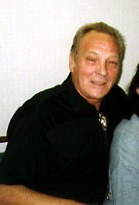Top Qs
Timeline
Chat
Perspective
Brian Lumley
English horror fiction writer (1937–2024) From Wikipedia, the free encyclopedia
Remove ads
Brian Lumley (2 December 1937 – 2 January 2024) was an English author of horror fiction. He came to prominence in the 1970s writing in the Cthulhu Mythos created by American writer H. P. Lovecraft but featuring the new character Titus Crow. He went on to greater fame in the 1980s with the best-selling Necroscope series, initially centered on character Harry Keogh, who can communicate with the spirits of the dead.
This article needs additional citations for verification. (January 2024) |
Remove ads
Biography
Summarize
Perspective
Born in County Durham, he joined the British Army's Royal Military Police and wrote stories in his spare time before retiring with the rank of Warrant Officer Class 1 in 1980[1] and becoming a professional writer.
While searching for books written by H. P. Lovecraft, Lumley contacted Lovecraft's publisher August Derleth. After reading some of Lumley's stories, Derleth invited him to contribute to Tales of the Cthulhu Mythos. [1] He added to the Cthulhu Mythos cycle of stories, including several tales and a novel featuring the character Titus Crow. Several of his early books were published by Arkham House.[1] Other stories pastiched Lovecraft's Dream Cycle but featured Lumley's original characters David Hero and Eldin the Wanderer. Lumley once explained the difference between his Cthulhu Mythos characters and Lovecraft's: "My guys fight back. Also, they like to have a laugh along the way."[2]
Later works included the Necroscope series of novels, which produced spin-off series such as the Vampire World Trilogy, The Lost Years parts 1 and 2, and the E-Branch trilogy. The central protagonist of the earlier Necroscope novels appears in the anthology Harry Keogh and Other Weird Heroes. The last entry in the Necroscope saga is The Mobius Murders.[3]
Lumley served as president of the Horror Writers Association from 1996 to 1997.[4] He served as Master of Ceremonies at the World Horror Convention in both 1992 and 1995.[5] In 1998 he was named the Grand Master of Horror and Author of the year at the Convention.[5] He received the 2009 Bram Stoker Award for Lifetime Achievement from the Horror Writers Association.[6][7] He also received a World Fantasy Award for Lifetime Achievement in 2010.[8] His short story Fruiting Bodies won a British Fantasy Award in 1989.[9]
Fans of Necroscope gathered at the annual KeoghCon from 2000 to 2007.[1] They were joined by Lumley and his wife Barbara Ann, known as "Silky".[1] The books have been published in thirteen countries and have sold over three million copies in the US.
Remove ads
Inspiration
Lumley's list of his favourite horror stories – "not complete by any means and by no means in order of preference" – included M. R. James' "Count Magnus", Robert E. Howard's "The Black Stone", Robert W. Chambers' "The Yellow Sign" from The King in Yellow, William Hope Hodgson's "The Voice in the Night", and H. P. Lovecraft's "The Haunter of the Dark" and "The Colour Out of Space".[12]
Bibliography
Summarize
Perspective
This is a list of Lumley's more notable novels and short story collections. This list of novels and short stories is not exhaustive. Lumley had many pieces published in periodicals and other publications, sometimes as works in progress or partial works, under his own name and jointly with other writers.
- The Subterranean Press edition
- Necroscope (novel)
- Brian Lumley's Freaks
- Introduction
- In the Glow Zone
- Mother Love
- Problem Child
- The Ugly Act
- Somebody Calling
- A Coven of Vampires (1998)
- What Dark God?
- Back Row
- The Strange Years
- The Kiss of the Lamia
- Recognition
- The Thief Immortal
- Necros
- The Thing from the Blasted Heath
- Uzzi
- Haggopian
- The Picknickers
- Zack Phalanx is Vlad the Impaler
- The House of the Temple
- Screaming Science Fiction: Horrors from Out of Space
- "Snarker's Son"
- "The Man Who Felt Pain"
- "The Strange Years"
- "No Way Home"
- "The Man Who Saw No Spiders"
- "Deja Viewer"
- "Feasibility Study"
- "Gaddy's Gloves"
- "The Big 'C'"
- The Taint and other novellas: Best Mythos Tales, Volume One (2007)
- "Introduction"
- The Horror at Oakdeene
- Born of the Winds
- The Fairground Horror
- The Taint
- Rising with Surtsey
- Lord of the Worms
- The House of the Temple
- Haggopian and other stories (2008)
- Introduction
- The Caller of the Black
- Haggopian
- Cement Surroundings
- The House of Cthulhu
- The Night Sea-Maid Went Down
- Name and Number
- Recognition
- Curse of the Golden Guardians
- Aunt Hester
- The Kiss of Bugg-Shash
- De Marigny's Clock
- Mylakhrion the Immortal
- The Sister City
- What Dark God?
- The Statement of Henry Worthy
- Dagon's Bell
- The Thing from the Blasted Heath
- Dylath Leen
- The Mirror of Nitocris
- The Second Wish
- The Hymn
- Synchronicity or Something
- The Black Recalled
- The Sorcerer's Dream
- The Nonesuch and Others (2009)
- Introduction
- "The Thin People"
- "Stilts"
- The Nonesuch
- The Fly-by-Nights (2011)
Remove ads
References
Further reading
External links
Wikiwand - on
Seamless Wikipedia browsing. On steroids.
Remove ads

